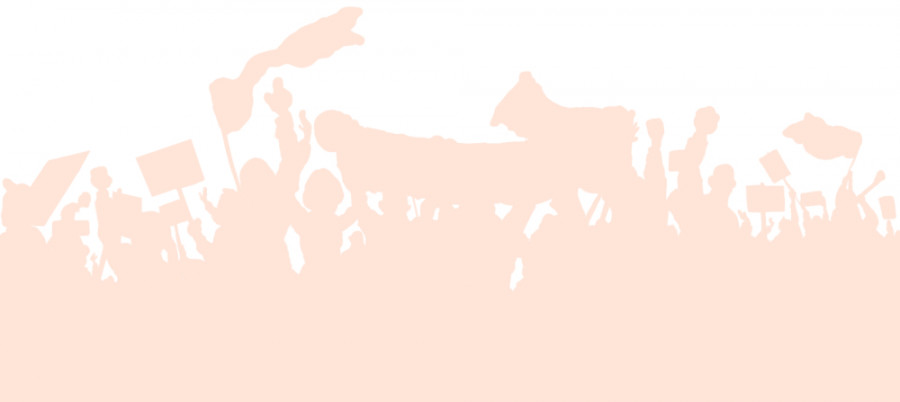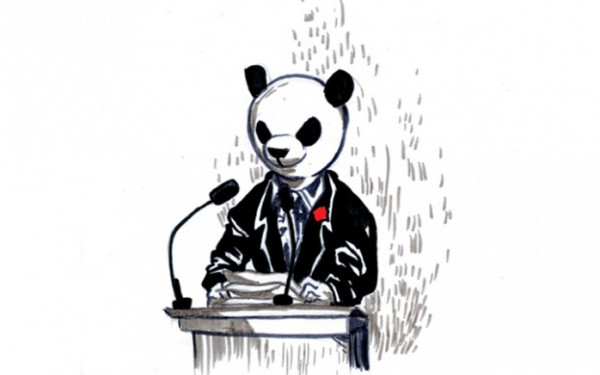The SPVM Violently Suppressed My Media RIghts
How the Montreal Police Used Intimidation and Violence to Impede on my Rights as a Journalist and the Rights of Protesters
Screaming like a possessed man is not the type of behaviour one expects from a trained police officer—then again, I’ve never interacted with a rogue undercover cop before.
Read this story on the 2016 Media and Democracy microsite here.
Approximately 100 young students gathered in downtown Montreal on Dec. 18 to protest state violence and recent public sector budget cuts implemented by Quebec’s Liberal government.
Montreal has been the main rendez-vous spot for mobilization against these issues for almost a year now. At its start, Friday’s demonstration wasn’t out of the ordinary.
By the end, it was anything but.
Sometimes, these manifestations become more about the number of arrests rather than why people choose to protest in the first place.
Ironically, one issue they attempted to protest that night ended up becoming a common headline story—police violence.
Like all protests, the Service de Police de la Ville de Montréal (SPVM) employed a unit of police in riot gear to shadow the march. It began at Place Émilie-Gamelin at 8:30 p.m. before heading east away from most signs of civilization and nightlife.
The first altercation between the armour-clad men and young masked demonstrators occurred on Ste. Catherine St. when firecrackers were shot in the direction of the police, who launched tear gas canisters in response.
A shootout ensued. The riot cops banged batons on shields and charged at anyone walking in the street. I had my first experience with the burning sensation of tear gas. By the time I composed myself, the protest had dispersed into small groups farther east.
Kevin Moore, who just moved to Montreal from Ontario, said he heard the commotion nearby and decided to film the events with what appeared to be a tiny GoPro camera. On Facebook, Moore shared footage from the same evening of an officer repeatedly knocking his back with a shield, as he calmly walked on the road.
Later, I saw a cop threaten him with arrest for “loitering,” even though Moore was standing on a sidewalk. Across the street, riot police surrounded and confined a handful of protesters in a kettle at the corner of Logan St. and Lartigue St. A few blocks away, three people were being arrested. Afterwards, the SPVM confirmed a total of nine arrests.
Rumours of undercover cops infiltrating the demo as Black Bloc impersonators began spreading on deserted, residential back-streets. Katie Nelson, a student from Concordia University, said one of these unidentifiable men assaulted her. An ambulance brought her to the hospital, and she later confirmed she suffered a concussion among other injuries—although she was less worried about discussing her well-being as we spoke on the phone briefly that night.
“I got attacked from behind by an undercover cop,” Nelson said while being taken to the hospital. “That’s not really important though because apparently one of them pulled a gun on someone.”
Nelson filed a lawsuit against the SPVM and the city of Montreal in 2013 for harassment.
Zachary Savard alleged he saw the incident of a gun being drawn. Suspicious of disguised officers, he said his group questioned a few men about their identities. “As we came to them, they just took a gun out, and said move,” Savard said.
An SPVM spokesperson said in an interview that officers dressed in “civilian clothes” were present. Asking for this official confirmation was really a formality. We saw them.
At 9:19 p.m., I tweeted that the demo had ended. Remnants of protesters, media and police hung around the entrance to the metro at Place Émilie-Gamelin.
“The undercover cops are over there,” someone shouted. A man apparently got pepper sprayed. He was on his knees as someone poured milk into his eyes to remedy the effects. Police in riot gear ushered everyone away.
I was confused. This was no bar fight. Intuitively I knew that this man was an officer, but there he stood without uniform or any sort of protocol and discretion.
Four men in plainclothes acted evasively and crossed the street to avoid angry protesters demanding answers about who they were. Finally, it seemed the secret police were found.
I approached one man dressed in a grey hoodie, a baseball cap, and khaki pants, but with no observable badge. He was stoic and had an almost trained, emotionless stare. In broken French, I asked if he was part of the SPVM. He replied, no. Was he there for the manif? Yes, he said.
In an ensuing commotion, a young man, Simon Dugrenier, was pushed onto the hood of a car by two of the undercover cops. They twisted his arms behind his back and violently dragged him down Berri St. to a parking lot.
Dugrenier said that they apprehended him because he photographed the two plainclothes officers with his phone. At various points throughout the ordeal, he described how the officers punched his stomach, put him in a chokehold, and delivered blows to his head, trying to coerce him into unlocking his smartphone.
I, along with my photographer, saw Dugrenier’s arrest, and followed them to the parking lot. The man I originally questioned stood in front of my colleague to impede his right to photograph the event.
According to Dugrenier’s account, he was dragged to the adjacent Labelle St., where they continually abused him until he gave up his password. They deleted his photos, he said.
With Dugrenier’s detainment out of our sight, a fourth undercover cop seemed to lose his control. Clearly aggravated, he began screaming at another protester. Scared, the protester ran, but not satisfied with instilling fear, the cop shoved the man face-first into the ground.
I was confused. This was no bar fight. Intuitively I knew that this man was an officer, but there he stood without uniform or any sort of protocol and discretion.
I was also there to cover the story, not become part of it.
I could only stare. This rogue cop turned to my photographer colleague and me, still screaming. We began to walk away, but he charged toward us and pushed me. We sprinted back toward the metro station. Those around who saw what happened mimed the international sign for a crazy person, while spewing obscenities in French and English to verbalize their shock.
At no point, did any of these men pull out a badge and identify as police. Dugrenier said the same. Intimidated and threatened with violence to leave, I couldn’t finish my job. I didn’t see firsthand the brutality Dugrenier alleged he experienced.
Now, he is left to fight a criminal charge of “intimidation” and other fines mostly on the basis of his word and memory. Like Nelson, he said he sustained a concussion and injuries to his arms.
I approached officers in uniform, asking rhetorical questions with the slimmest hope that someone could help. They told me to move away from the area.
I felt powerless. There was no accountability. The only recourse was to write a story.
Nelson and Dugrenier are both collecting evidence to combat charges and potentially pursue legal action against the SPVM.


_600_832_s.png)

_600_375_90_s_c1.jpg)
3web_600_375_90_s_c1.jpg)
(WEB)_600_375_90_s_c1.jpg)
